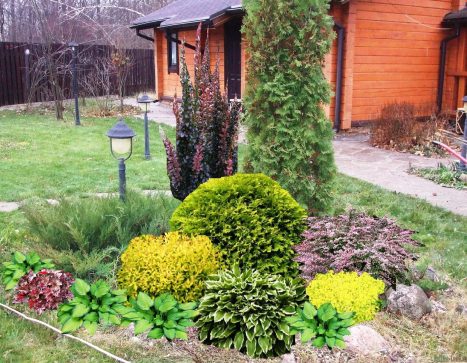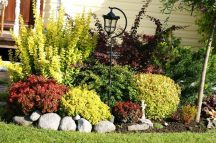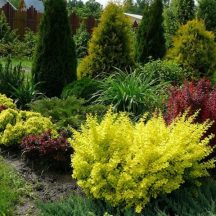This plant has many faces. Among its many species, one can find shrubs that are highly decorative, and individual plant species have edible fruits of a sour taste. In 100 g of berries - 5 daily norms of vitamin C and 2.5 norms of vitamin A. From this plant an impenetrable hedge is obtained, and also it is a natural healer, which saves from many diseases. All this is about barberry, planting and care of which does not present any special difficulties.
Material Content:
Types and varieties of barberry
There are about 500 wild species and varieties of barberry in nature. Many of them gave birth to cultivated varieties and there are also many of them. When crossing different species, we got plants that are very decorative.
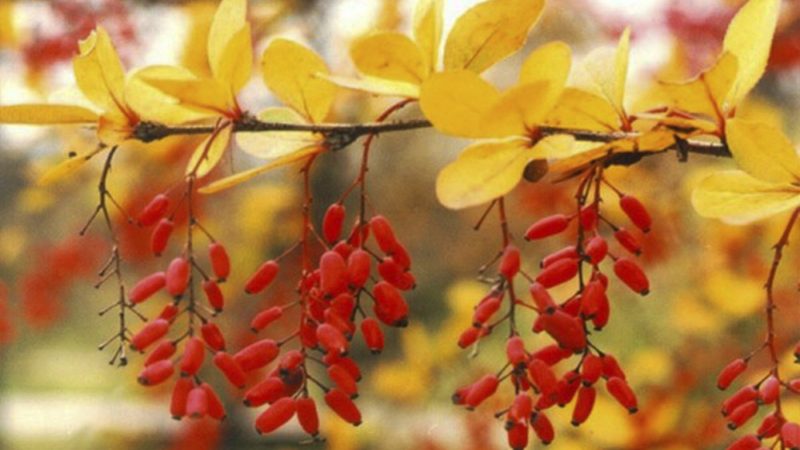
The most famous natural forms are the following:
- Barberry ordinary. Inhabitant of the southern regions of our country. It grows to 2.5 m. The arched yellowish-brown shoots are covered with dark green ovoid leaves and tripartite spines, reaching a length of 2 cm. At the end of spring, bushes are covered with fragrant flowers collected in a brush. Edible bright red fruits more than 1 cm long ripen in autumn. Their taste is sour, refreshing. There is also a red-leafed form - Atropurpurea, up to 2 meters high with orange-yellow flowers and dark red fruits. And also found variegated - Albovariegata.
- Amur barberry. He is from the Far East and grows also in China and Japan.Shrubs up to 3.5 m tall are decorated in spring with long tassels of flowers, and in autumn, with shiny edible juicy-red fruits that do not crumble for a long time.
- Barberry Canadian. In Russia, it is rare. The tall bush consists of shoots of dark purple color and is characterized by abundant fruiting.
- Ottawa barberry. This is the result of the hybridization of Thunberg barberry and the shape of an ordinary barberry with red leaves (Atropurpurea). The bush grows to 2 meters. Yellow flowers have a reddish hue, and its fruits are dark red. One of the most famous varieties of this species is barberry Ottawa Superba. It has very decorative leaves of dark red color and unusual red-yellow flowers. The variety is winter-hardy and almost not affected by diseases.
- Barberry spherical. This is a fairly frost-resistant shrub native to the mountainous regions of Central Asia. It differs not only not by barbed leaves, typical for barberry, but also by spherical edible fruits of dark blue color.
- Barberry of Thunberg. It forms a low, sprawling bush with small leaves and beautiful fruits with a bitter taste, unsuitable for food. This view is most suitable for decorating gardens and parks. For this, numerous varieties are bred: Aurea and Bonanza gold with yellow leaves, Red Chief with dark red leaves, Harlequin and Kornik with variegated foliage. One of the most famous is the barberry of Thunberg Atropurpurea. Its bush up to 1.5 meters high is covered with purple-red foliage that changes color in autumn to bright carmine. The real decoration of the plant are the yellow flowers collected in the brush with red stains.
Planting shrubs in the garden
Most varieties of garden barberry are unpretentious, but still they have their own preferences and they need to be considered when planting plants in the garden.
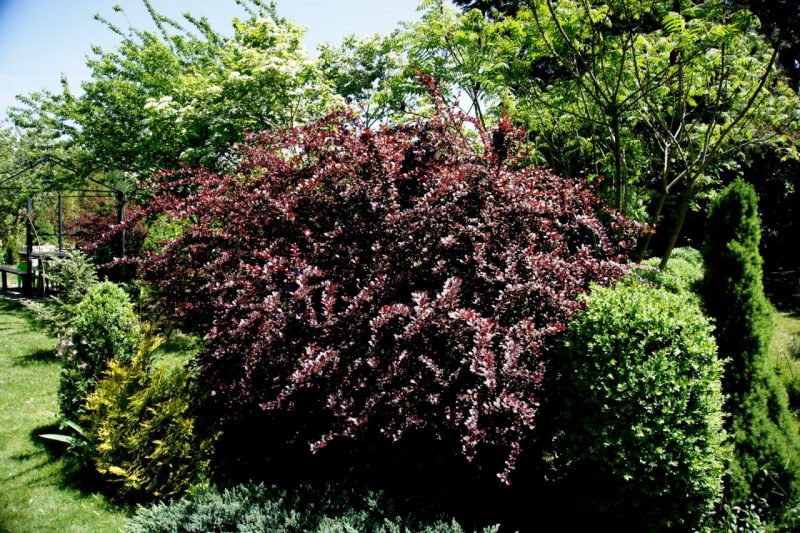
How and when to plant?
Planting time depends on which root system the seedling was purchased with - closed or open. In the first case, planting can be carried out throughout the growing season.
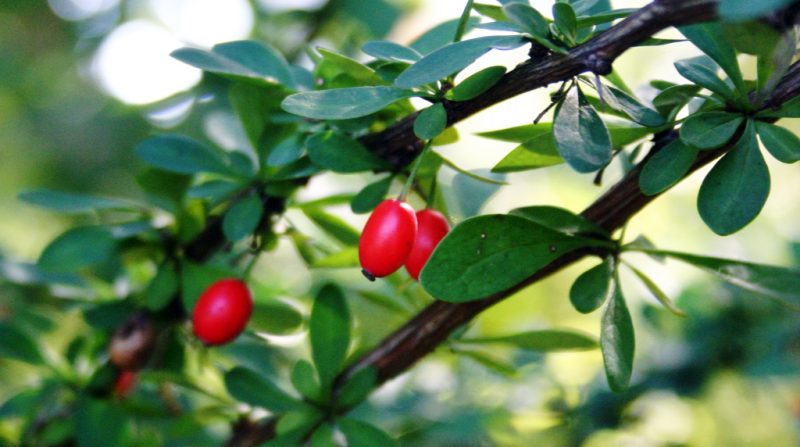
In the second, her time is limited to two periods:
- in the early spring, until the buds had bloomed, but the ground had already thawed;
- autumn at the time of leaf fall, but at this time, planting is associated with a risk of freezing of the plant in winter.
Since the rhizome of barberry is creeping and located in the surface layers of the soil, they do not dig a large hole for it. Its diameter depends on the age of the bush.
- For kids 2-3 years old, a hole with a depth of 25 cm with the same diameter is enough.
- For 5-7 year old plants, it should be larger - with a depth and diameter of about 50 cm.
- When using barberry bushes as hedges, they are not limited to pits, but they dig a trench 40 cm wide and 40 cm deep over the entire length of the plantings.
But in any case, the landmark is the size of the root system of the seedling. She should not be crowded in the landing pit. You need to prepare a place for barberry in advance so that the soil has time to settle, and there are no voids in it.
After a layer of drainage of pebbles or broken brick is laid at the bottom of the pit, it is filled with a soil mixture of the following composition:
- humus or well-ripened compost - 1 part;
- garden land - 1 part;
- sand - 1 part.
Each bush will need 200 g of ash and 100 g of superphosphate. Planting pit shed with water. If the seedling is grown in a container, before planting it, together with the container, it is immersed in water for 20 minutes so that the earthen lump is well saturated with water. For plants with an open root system, the soaking time is longer - from 2 to 3 hours, and it is good to add a root stimulant to the water. If the roots are not dry, the seedling can not be soaked, but sprinkle the root system with a root stimulant.
If several bushes are planted when choosing a layout for their placement, you need to remember that they grow greatly in width, so the distance between them should not be less than 1.5 m.The exception is only planting as a hedge - 2 plants are planted per 1 running meter.When planting, it is very important not to bury them; the root neck should be slightly above the soil level.
Location and soil requirements

All barberries are drought-tolerant plants, they do not need moist soil, so places with high standing groundwater or flooded in spring are not suitable for them.
They are demanding on lighting. In the shade and even partial shade, the color intensity of the leaves decreases, and fruiting will be weak.
In nature, barberries most often grow in the sand; in culture, they have not changed their preferences - they love light soil. Heavy clay-rich soils will have to be improved by adding sand. The soil reaction should be neutral or very close to it. Acidic soils necessarily lime.
Barberry Care
A correctly planted bush does not require special care, but in order for it to show itself in all its glory, the gardener will have to take care of it.
Watering a plant
Only recently planted plants need weekly watering. When they have taken root, they should be watered only during drought and in extreme heat. Water should be heated in the sun. If immediately after planting, the earth around the bush is mulled with shredded wood chips, bark or nutshells, this will not only reduce watering to a minimum, but also stabilize the temperature regime of the soil and make it more loose.

Fertilizer and fertilizer
Natural species often grow on poor soils and feel great there. Garden forms are more demanding for food. In the first year, the plant has enough of the nutrients that are planted.
Starting from the second year of life, the feeding scheme is as follows:
- in the spring - nitrogen fertilizers: 20 g of urea per 10 liters of water;
- before flowering - a complete mineral fertilizer with trace elements (it can simply be planted in the soil, and then water the bushes);
- in September, 10 g of potash and 15 g of phosphorus fertilizers are applied under each adult plant, planting them in the soil.
Every 2-3 years in the spring, it is recommended to feed organic matter: on a bucket of water, 1.5 liters of slurry or a liter of insisted bird droppings. After such feeding, watering is necessary.
Pruning
This is the most difficult job when caring for this shrub. Numerous sharp spikes can severely injure hands, therefore tight, better leather gloves are needed.
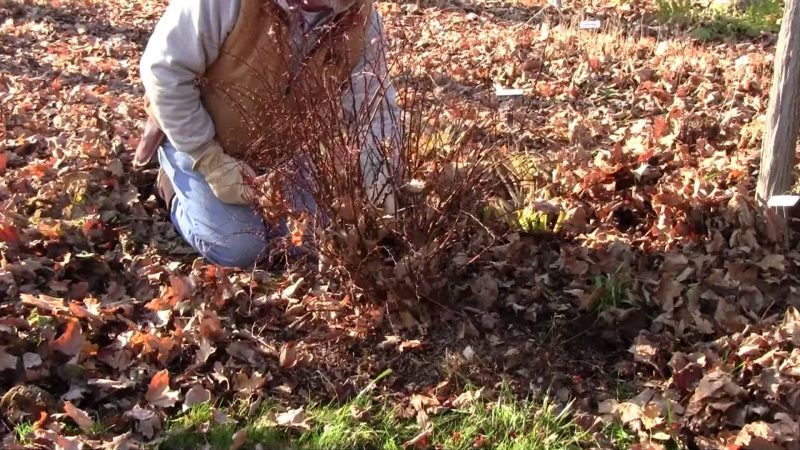
- Sanitary pruning is done annually in the spring, removing all frozen and dried shoots.
- For the formation of bushes, pruned only after flowering, as it occurs on last year's shoots.
- A hedge of tall bushes begins to form in the second year after planting.
In adult specimens, annual trimming of annual and biennial branches is carried out by half or a third. Low-growing border varieties are usually not pruned.
Care in the fall, wintering
Winter is a difficult test for newly planted bushes, especially if it is not too frost-resistant Thunberg barberries. Plants are being prepared for it in the fall. Timely spent autumn top dressing and water-charging irrigation after leaf fall will help barberry better prepare for winter. But this is not enough.

All young (and at Thunberg's barberry and grown up) plants need to be covered. Before shelter, they must be hardened in small frosts, therefore, they begin the procedure with a persistent decrease in temperature to -5 degrees and freezing of the soil to a depth of 3 cm. For this shrub, not only frosts are dreadful, but also dampness, which poses a threat of evaporation, therefore, shelter should to be dry air.
Small bushes are easily covered with spruce branches and dry foliage, taking care of protection from mice. Thunberg's barberry is first wrapped in burlap or kraft paper, and wrapped with covering material on top, securing the shelter so that it does not unfold. At the base of the bush you need to provide space for ventilation. Remove winter protection in the spring on time to give the bushes complete freedom for vegetation.
Propagation of barberry
Shrub barberry propagated by both the vegetative parts of the plant and seeds.
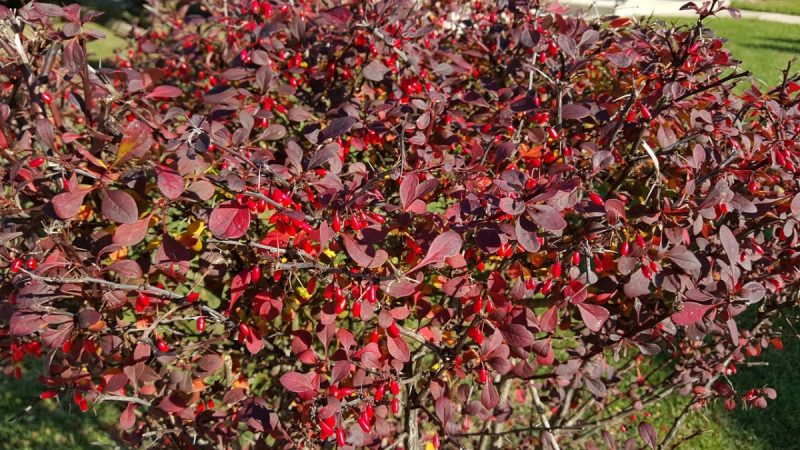
The division of the bush is possible only in those forms that branch from its base. Usually divide bushes at the age of 3-5 years. It is especially convenient to divide the plant if it is planted with some deepening. On each divide there should be stems and part of the roots. A secateurs are used for the procedure.
Cuttings in some types of barberry take root poorly, but new plants will be similar to parents. This is a good way to get a lot of the same plants for hedges.
Propagation by cuttings
June cuttings, cut in the morning, take root best. They are taken from the middle part of the green shoot of the current year. Lignified cuttings take root much worse.
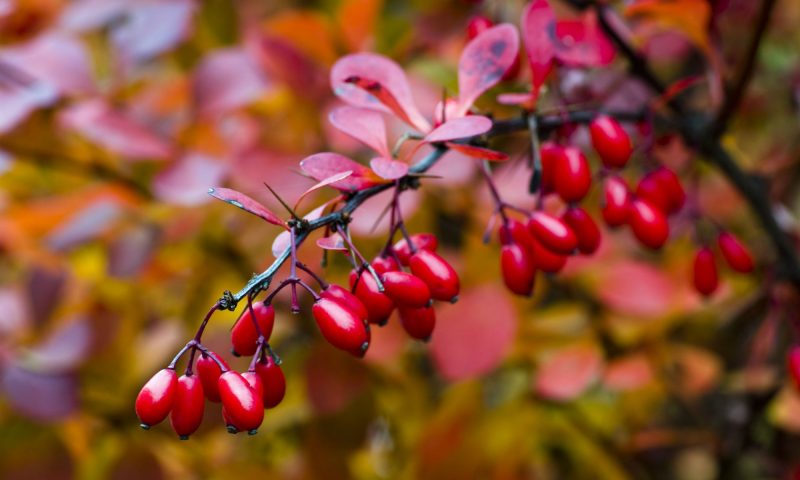
- The stalk should have 4 leaves and one internode. Its length is about 10 cm, and its thickness is about 0.5 cm. The cut at the top is horizontal, at the bottom, at an angle of 45 degrees.
- The lower leaves are removed, the upper ones are shortened by half. Spines do not clean.
- The lower part of the handle is treated with a root stimulant.
- Cuttings are planted in a greenhouse with an arc height of about 20 cm. The soil is leafy, sprinkled with a layer of sand 4 cm thick, well moistened. Landing pattern: 5x7 cm, tilt angle - 45 degrees. They are deepened by 1 cm.
- Maintenance conditions: always moist soil, air humidity of about 85%, frequent spraying. The use of an artificial fog plant increases the survival rate.
Cuttings overwinter in a greenhouse, plants are planted in a permanent place after 1-2 years.
During seed propagation, most plants will not repeat their parents, with the exception of the form of barberry ordinary Atropurpurea. Most of these seedlings will retain varietal characteristics. Seed germination is low - in different species from 20 to 40%.
Seed propagation
- The largest berries are freed from the pulp, washed and dried.
- When sown in the autumn on a planting bed, the seeds undergo a natural stratification. In winter, they are stratified in the refrigerator from 2 to 4 months, depending on the type of shrub. Sown in the spring in the garden.
- Seedlings thinned out in phase 2 of real leaves, but do not dive or transplant. They are relocated to a permanent place only after 2 years.
The main problems when growing
If initially a suitable place for planting was chosen and it was made correctly, there should be no problems in cultivation. But in the cold rainy summer bushes can be affected by fungal diseases.
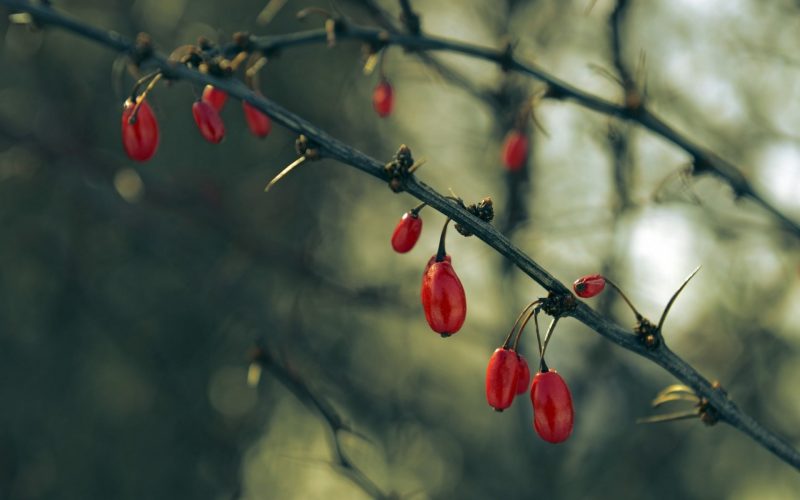
Pests, diseases and methods of dealing with them
There are not so many of them, but they can bring serious harm to the plant.
- Powdery Mildew It appears as a white coating on all parts of the plant. Heavily damaged leaves and stems are removed. The whole plant is treated with colloidal sulfur.
- Rust. Characteristic orange spots appear on the leaves. Control measures - treatment with copper-containing preparations or colloidal sulfur.
- Spotting. Spraying with copper oxychloride.
- Bacteriosis If the upper part of the plant is damaged, all diseased branches are cut. If the base of the trunks is affected, the plant is uprooted and burned.
- Barberry aphid. Spraying with soapy water.
- Barberry sawfly and flower moth. Treatment with a solution of chlorophos 2% concentration.
Shrub decorative application
A wide variety of species and plant varieties allows you to choose a suitable bush for garden design in any style. It is often used in landscaping. A bush with brightly colored foliage can become a tapeworm or fit into an existing composition of plants. It will adorn a mixborder, and low specimens will be appropriate on an alpine hill. From barberries, a beautiful hedge is obtained in its natural form or formed by pruning, which this plant tolerates well.


